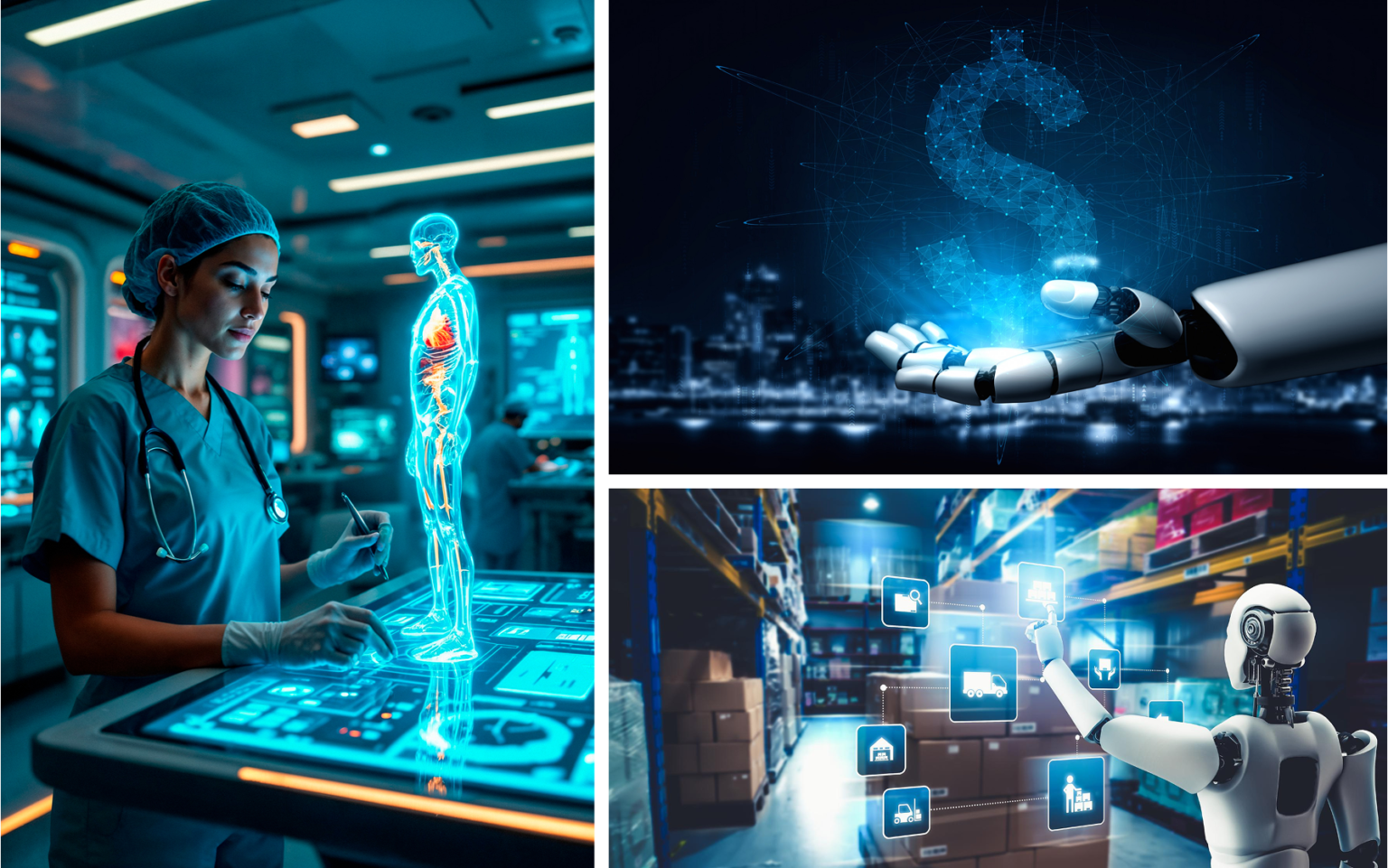Introduction: The Urgent Shift Toward AI
In the fast-changing digital world of today, Artificial Intelligence (AI) has become the biggest technological advancement after the Internet. Whereas AI was previously regarded as the forte of startups and tech giants, it is now reaching the very heart of traditional sectors such as manufacturing, healthcare, finance, and retail. These industries, typically marked by legacy systems and manual processes, are now realizing the huge difference AI can make to performance, efficiency, and long-term ROI.
With global spending on AI expected to surpass $500 billion by 2027, companies that delay adoption risk losing relevance and competitiveness. AI is not about replacing jobs; it’s about amplifying human capabilities, automating repetitive tasks, and unlocking new levels of insight and innovation. In this blog, we’ll dive into how AI-powered solutions are reshaping traditional industries, explore real-world applications, and show how OpenUI can help organizations harness this revolution.
What Are AI-Powered Solutions?
AI-powered solutions are technologies that mimic human cognitive processes. These are:
- Machine Learning (ML): Computers that learn from experience to get better over time.
- Natural Language Processing (NLP): Allows machines to read and communicate in human language.
- Computer Vision: Understands visual information from the world, applicable for surveillance, quality inspection, etc.
- Robotics & Automation: Does tasks complex or repetitive better than humans.
Unlike conventional software, AI solutions learn and improve continuously, providing a tremendous advantage in decision-making, productivity, and cost savings.
The Impact of AI Across Traditional Industries
Manufacturing: Smarter, Safer, and More Predictive
The manufacturing sector is experiencing a revolutionary change due to AI.
- Predictive Maintenance: AI sensors identify equipment anomalies, avoiding expensive downtime.
- Computer Vision for Quality Control: AI detects defects at a micro level, improving product quality.
- Supply Chain Optimization: Algorithms predict demand, automate purchasing, and control logistics.
Impact: According to a McKinsey report, manufacturers using AI can enhance productivity by 20-30%, with a significant decrease in waste and error rates.
Also, digital twins—virtual copies of physical assets—are becoming popular. These AI and IoT-powered models mimic real-world scenarios, allowing predictive decision-making and operational effectiveness.
Healthcare: Personalized, Accurate, and Efficient

AI is making it possible to transition from reactive to proactive and predictive care in healthcare.
- Medical Diagnostics: AI identifies cancer in early stages from scans more precisely than human radiologists.
- Drug Discovery: AI speeds up research by processing millions of compounds rapidly.
- Patient Support: AI chatbots handle routine questions, allowing professionals to focus on critical care.
Impact: A study in 2023 revealed hospitals utilizing AI-powered tools experienced a 50% decline in diagnostic mistakes and increased patient satisfaction.
Wearables connected with AI are also transforming patient monitoring. From monitoring vitals in real time to warning doctors of unusual readings, AI is making quicker response and preventive measures possible.
Retail: Predictive, Personalized, and Profitable
From inventory management to customer care, AI is enabling retailers to make every touchpoint better.
- Recommendation Engines:< Using historical behavior, AI anticipates what shoppers will purchase.
- Dynamic Pricing: AI dynamically prices in real-time based on demand and competition.
- Customer Support Automation: AI processes FAQs and returns, offloading staff burden.
Impact: Retailers using AI applications reported sales conversion up to 25% and cart abandonment by 30%.
In addition, visual search and voice shopping are increasing convenience. AI assists shoppers in finding products quicker while enhancing differently-abled user accessibility.
Finance: Secure, Smart, and Streamlined
AI assists financial institutions in delivering faster, wiser, and more secure services.
- Fraud Detection: AI tracks transactions to detect anomalies in real time.
- Robo-Advisors: Deliver personalized investment advice to clients at scale.
- Document Processing: NLP scans thousands of documents in seconds for auditing and compliance.
Impact: AI in finance has reduced fraud-related losses by 40% and accelerated customer onboarding speed by as much as 70%.
AI is making financial planning smarter, too, with forecasting powered by AI. Algorithms are able to run models of market scenarios and offer advice on risk management, budgets, and investment plans.
Hospitality: Personalized Guest Experiences at Scale
Hotels and restaurants are using AI to deliver personalized, frictionless service.
- AI-Powered Concierge: Virtual concierges handle reservations, inquiries, and upselling promotions.
- Behavioral Analytics: AI is used to customize offers based on guest behavior.
- Back-Office Automation: Decisions regarding staffing, housekeeping, and the supply chain are optimized through AI insights.
Impact: Hotels incorporating AI have recorded a 15% boost in customer satisfaction along with reduced costs of operations.
Facial check-ins, voice assistants based on AI in guest rooms, and dynamic pricing in rooms are turning into industry standards at a fast pace.
New Trends: The Future of AI in Traditional Industries

The future of artificial intelligence exceeds automation. Consider primary trends reinventing traditional sectors:
- Edge AI: Processing at edge devices to produce real-time outputs (i.e., inside factories or hospitals).
- AI + IoT (AIoT): Coupling AI and sensors for intelligent operations across manufacturing and supply chain.
- Explainable AI: Technologies enhancing explainability behind AI decisions, absolutely necessary for finance and medicine.
- Autonomous Systems: Ranging from automated delivery robots to automated warehouse administrators.
Also, Generative AI is beginning to impact content creation, product design, and training. For instance, businesses now employ AI to model customer behavior and test new services in virtual environments.
Traditional industries adopting these trends are not only streamlining existing operations; they are future-proofing their companies.
Key Benefits of AI in Traditional Industries
- Better ROI through process optimization and minimized downtime
- Smarter, faster decisions with real-time analytics
- Better customer experiences through personalization
- Higher scalability with lower marginal costs
- Less operational risk with precise forecasting and monitoring
- Higher compliance and data integrity
Challenges in AI Adoption
Even with advantages, AI adoption comes with its challenges:
- Setup and Training Costs: High setup and training costs.
- Data Readiness: Traditional businesses often do not have clean, structured data.
- Legacy System Integration: AI has to deal with old IT infrastructure in many cases.
- Lack of Talent: Shortage of AI developers and data scientists.
But with the right planning, stakeholder education, and strategic partner, these can be overcome. Firms that focus on AI literacy and strategic alignment will be more successful.
How OpenUI Can Help You Leverage AI
Our team at OpenUI has expertise in AI-led digital transformation. We enable traditional enterprises to maximize the potential of AI with:
- AI Readiness Assessment: Determine where AI can produce the best ROI in your business.
- Custom AI Solutions: Industry-specific AI tools developed to meet your business’s distinctive requirements.
- Smooth Integration: We upgrade your technology stack without affecting your existing workflows.
- Data Visualization & Insights: We transform difficult data into easy, actionable insights.
- Rapid Prototyping & Deployment: Accelerate your digital transformation with speedy execution.
From idea to scale, OpenUI provides AI solutions that generate measurable impact and create exponential ROI.
Conclusion: Embrace the AI Advantage Now
AI is not a choice for legacy industries anymore—it’s a necessity for growth, resilience, and staying relevant. From keeping costs low to keeping customers happy and making more informed decisions, AI-driven solutions give a competitive advantage that legacy systems just can’t offer.
By joining forces with veteran teams such as OpenUI, companies can steer clear of usual mishaps and accelerate their AI reinvention journey. The earlier you begin, the higher your long-term returns.














